Having participated in multiple shows each year over her nearly 40-year career, Kim Abeles challenged herself to consider ˌterə ˈfɜːmə (terra firma) at the Frank M. Doyle Arts Pavilion at Orange Coast College as possibly her last solo exhibition.

Kim Abeles, photo by Ken Marchionno
“Terra firma means solid ground, and I realized I am not on solid ground,” she reflected. “The real process of the show was me trying to come down from the sky, which is where most of my thoughts usually reside, and think about finding my grounding. It felt like I either figure it out now, or I’m not going to figure it out—it really felt pressing like that.”
The conceptual umbrella of the show originated with Kim Garrison Means, the interim gallery director and curator of the show, who selected the title for its use of Latin feminine endings. She remarked, “As we were formulating the show, Kim said, ‘We’ve treated our women historically the way we’ve treated the earth.’ There was the connection between our wanting to take advantage of and lord over the earth, and a parallel in history of our treatment of women and people not in a position of power. And all the works in this show highlight our relationship to nature or to people that walk upon the earth.”
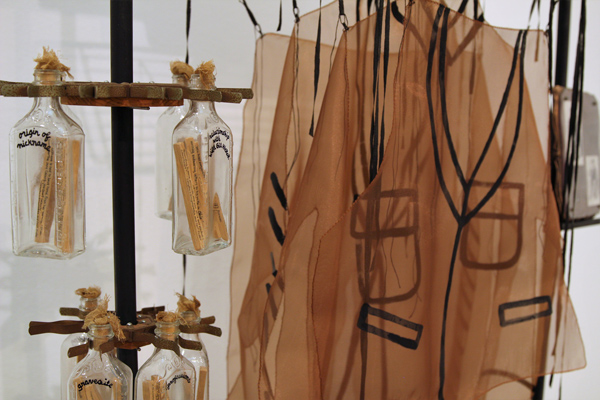
Calamity Jane and Questions of Truth
In deciding with Garrison Means among her copious bodies of work to include in the show, Abeles found she first needed to deconstruct the title into phonemes, then reconstruct the title as a visual, concrete object. “To me, ideas are all about dissecting things and trying to reassemble them in another way that makes a different understanding,” she explained. Particularly drawn to the mirrored triangles denoting “r” in “firma,” Abeles observed that they seemed “figurative,” conjuring “an hourglass, female form” and “heaven and earth,” thus pointing her to works referencing women and dualities.
Abeles’ faith in and reliance on visual materiality to guide the way to meaning and truth form the common root of her processes of investigating and exposing systems of manufactured realities throughout the show. Boldly calibrating her methods of gathering objective evidence in patriarchal arenas to the scale and subjectivity of her own body, she bounded and traversed terrains on foot, tasking herself with gathering natural, artifactual, and digital data where human attention has collectively cast a blind eye. She ultimately crafted material assemblages that tell at once concentrated and comprehensive stories of how and where systems and spectrums of dualities have fissured, as well as where solutions lie.

Forty Days and Forty Nights (Forty Days of Smog)
In her widely known works concerning smog, including Forty Days and Forty Nights (Forty Days of Smog), Abeles exposes our asphyxiating yoking of sky to ground. Recognizing that activating modern consciousness requires the delivery of empirical data through a relatable and compelling story, she grounded her data collection method—of leaving domestic objects outside for days with stenciled adhesive to passively collect smog—in viscerally persuasive irony. As we walk through a room with her daughter’s former highchair and a life-size dining table composed of car mufflers, we directly confront the causal link between the mufflers and smog covering the tabletop images of food.
Abeles similarly confronts in a boots-on-the-ground manner how overzealous industrialization and commercialization strain the dyad of home and nature in Signs of Life (diptych), where she located on foot every tree and homeless encampment within an area around her studio in Los Angeles, and created 1:1 mappings of her findings on a scale that render them fully apprehensible from one stance. Garrison Means observed, “Downtown Los Angeles at the time didn’t have housing where her studio was for humans to occupy, nor did it have residential space for living plants. So she’s making a comparison between the placement of public trees and the homeless, and mapping the two signs of life she can see in that ecosystem.”
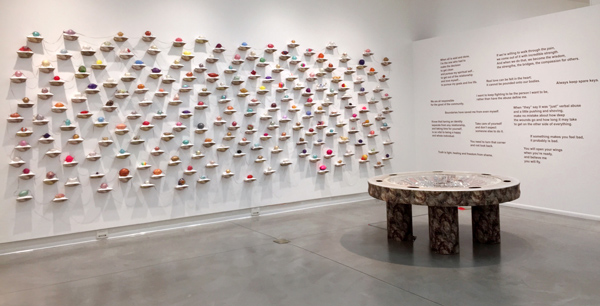
Pearls of Wisdom (End-the Violence) courtesy Kim Abeles
Pearls of Wisdom (End the Violence) illustrates, alternatively, how a mutually supportive relationship between an individual and her community can be germinated and strengthened through artmaking itself. Partnering with A Window Between Worlds, a Venice-based organization championing artmaking as a conduit for healing, Abeles engaged survivors of sexual and domestic violence in transforming a physical remnant of their abuse into a densely substantial and uniquely beautiful pearl. “On mirror paper they write a story, and their reflection is in there the whole time so it’s a profound experience,” Abeles elaborated. “They wrap that symbol [of the abuse] within that story, wrap this with an empowering color of cord, and then wrap that with bandages, mix plaster and cover it, and ultimately paint it.” Of the 200 pearls lining a wall of the gallery beside words of wisdom participants would share with other women, Abeles said, “To me, it’s like a choir singing. This was about physically centering oneself, and listening to other people sharing experiences and seeing their collective value.”
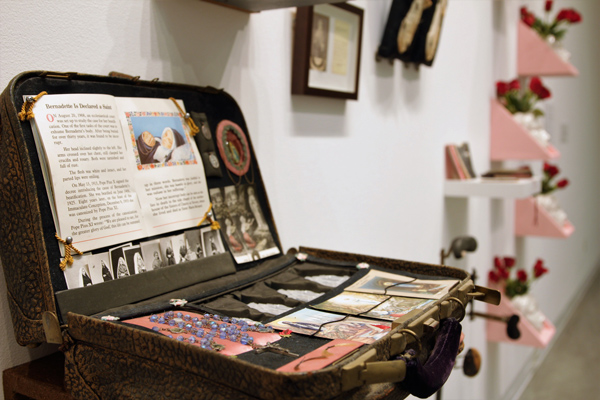
The Image of St. Bernadette
Abeles illuminates our historically more riddled negotiations of story and truth in the back rooms of the gallery, which feature contradictory or male-generated tales about several women in history, including Calamity Jane, Joan of Arc, and St. Bernadette. Reflecting her signature method of storytelling-reportage, marked by ironically neutral montaging of incompatible candidate truths, each of these works intercut cultural narratives idealizing or commodifying women into serviceable icons, with emblems of the women’s unperturbable, self-generated beliefs about their missions and identities.
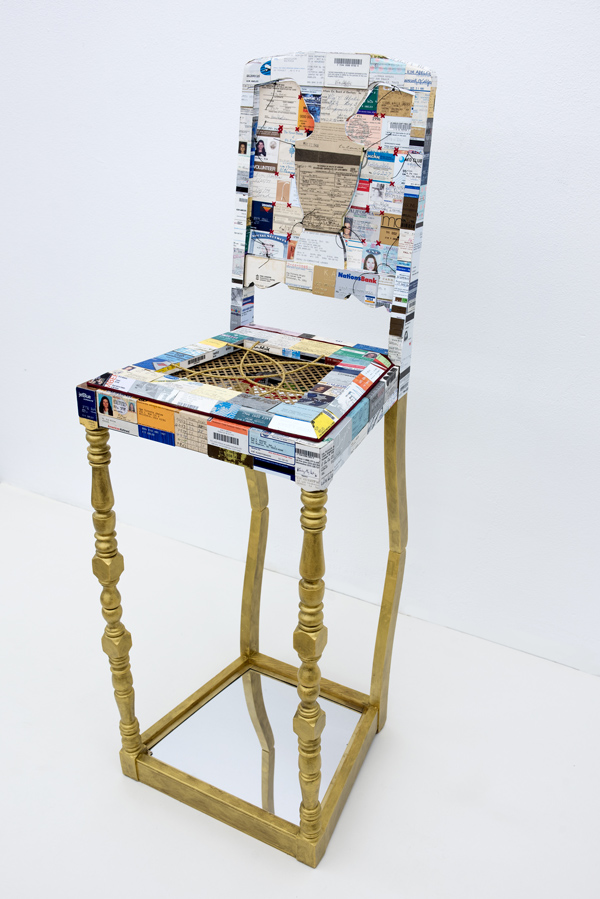
Self-portrait (Pope Joan) courtesy Kim Abeles
In Self-portrait (Pope Joan), alluding to how Pope Joan was stoned to death after she was found out to be female, Abeles upholstered a chair with her own identification cards to illustrate our persistence in proving and approving of the existence of human bodies by markers, labels and numbers in lieu of fully embodied, soul-to-soul interactions. A body would surely fail to be physically supported by this seatless chair, designed to verify the genitalia of candidate popes (and likely borrowed from a house of cards).
The show weaves in several other bodies of work, including Sweet Dreams, Legend for Shared Skies, Women and Water, and new valises created in partnership with incarcerated women who serve as firefighters that will be used by park rangers to educate the public about fire prevention.
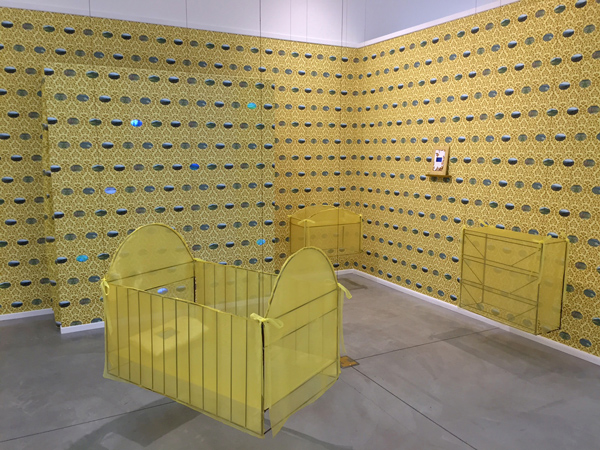
Sweet Dreams courtesy Kim Abeles
“If there’s a thread that goes through the show, it’s that every piece has to do with my life at the time,” Abeles disclosed. “I’ve been in situations with domestic violence—did I know that when I started? No, it was totally buried in my tough way of going through life. Or my feeling about the trees [in Signs of Life (diptych)]—it was because I was so upset I had no place to walk my dog. St. Bernadette—it was because for a while I felt such like a commodity, dealers just wanted me to pump out works that were selling well, [just like] they were trying to make a buck off her on holy cards down the street.”

The Image of St. Bernadette, courtesy Kim Abeles
For Abeles, finding her grounding through the show thus comes in part through recognizing that its anchoring and generative center is her uncompromising honoring of her body’s experiences through personally meaningful epochs of her life. She offers her truth through systematic subjectivity as an alternative to realities resulting from the yoked agendas of domination and neglect. The show, in turn, grounds us as viewers by centering us in spaces scaled so that we can conceptually witness all parts of a system at once from start to end, as well as viscerally experience our complicity in its dysfunction. Ultimately, the invitation into these systems is a hopeful and celebratory one, as Abeles models through her own relentlessly productive creativity how we can persistently deploy our presences and imaginations toward healing and sustainable forms of progress.
Photos by Jennie E. Park, except when courtesy Kim Abeles and otherwise noted.
terə ˈfɜːmə closes with a reception 1-3pm on December 2, 2017 at Orange Coast College in Costa Mesa.


















I have not seen this exhibit but felt as though I had after reading your excellent review.
Terrific exhibit and article! I was lucky enough to hear her talk at Irvine Fine Arts Center.